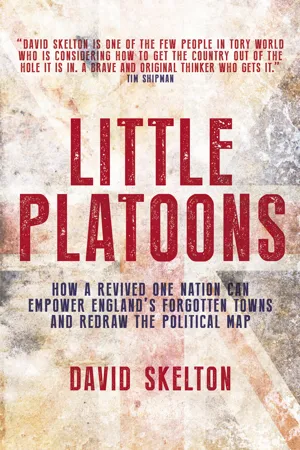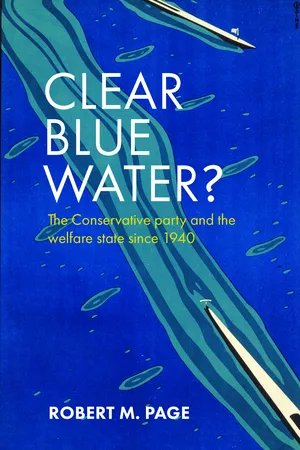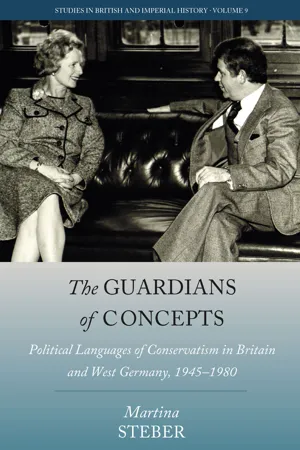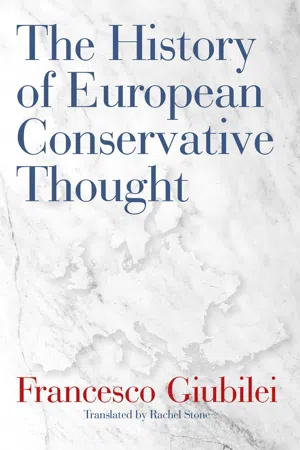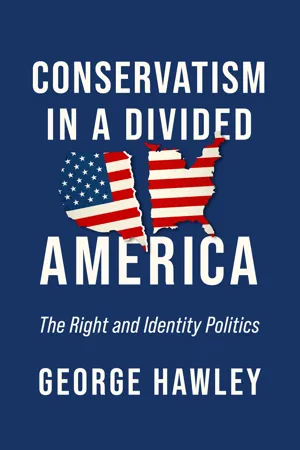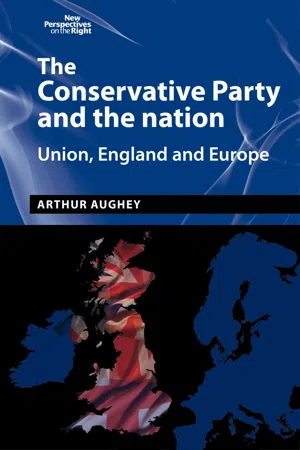Politics & International Relations
One-Nation Conservatism
One-Nation Conservatism is a political philosophy that emphasizes social cohesion and seeks to bridge the gap between different social classes. It advocates for a mixed economy, social welfare, and a sense of national unity. This approach aims to address social inequalities and promote a more inclusive society through government intervention and support for traditional values.
Written by Perlego with AI-assistance
Related key terms
Related key terms
1 of 4
Related key terms
1 of 3
8 Key excerpts on "One-Nation Conservatism"
- eBook - ePub
Little Platoons
How a revived One Nation can empower England's forgotten towns and redraw the political map
- David Skelton(Author)
- 2019(Publication Date)
- Biteback Publishing(Publisher)
Nevertheless, this is fundamentally a book about practical politics in 2019. Boris Johnson has made clear that he believes in the One Nation tradition and believes that the state must act where necessary, particularly around infrastructure, suggesting that One Nation ideas remain important. My aim has been to make clear how elements of the Tory tradition are more relevant than ever today and how they can be used to drive a fundamental realignment of politics.A BELIEF IN NATIONAL UNITY
One Nation may well be the only political idea to start from a belief in a fundamental national unity, rather than a country divided by class or sectional interests. In our divided kingdom, an ideology that aims for unity rather than division has much to recommend it.Lord Hailsham argued in 1959 that this belief in national unity made Tories stand out from their opponents:The Conservative Party is based on its love of country … Conservatism derives its inspiration and seeks to base its policy on what Conservatives believe to be the underlying unity of all classes of Englishmen, their ultimate identity of interest, their profound similarity of outlook, the common dangers and difficulties they have shared in the past, and with which they are still faced, and the necessity for unity as the true means for meeting them together … Harmony, not struggle, is its ruling political objective.Tories have long argued that their political opponents were too keen to see themselves as representatives of one particular element of society. The nineteenth-century Liberals were representatives of the capitalist class and modern socialists have been portrayed only as representatives of one element within society. One Nation rejects the class division that dominates socialist thinking and the narrow view of ‘economic man’ that shaped liberal political thought. Instead, it sees citizens as belonging to an organic community, with responsibilities and motivations beyond the purely economic. From the belief in unity flows a determination that no part of the country should be left behind. One Nation conservatism has no wish to see or preside over two nations. This often came from personal experience – for example, what Disraeli witnessed while researching his condition-of-England novels and what Macmillan saw while serving in the First World War and when MP for Stockton during the Great Depression. Unity means that certain parts of the country shouldn’t benefit at the expense of others and that government has a duty to do something to help create a united country. This is driven by the belief that we are part of a broader community, with wider and deeper responsibilities beyond pure self-interest. - eBook - ePub
Clear Blue Water?
The Conservative Party and the Welfare State since 1940
- Page, Robert M., Robert M. Page(Authors)
- 2016(Publication Date)
- Policy Press(Publisher)
tradition can be traced back to Disraeli’s stark observation about the two ‘strangers’ (the rich and the poor) in British society whose only common reference point was their ‘inhabiting’ of the same terrain. It places great emphasis on the need to maintain social unity within an economically unequal society. The pursuit of this goal has led One Nation Conservatives to accept the case for economic interventionism and state welfare.Another ‘contemporary’ classification scheme has been provided by Peter Dorey (2011) in his study of British Conservatism and inequality. Dorey distinguishes between One Nation Conservatism, neo-liberal Conservatism and post-Thatcherite Conservatism. In terms of the second of these categories, Dorey equates ‘neo-liberalism’ with ‘those Conservatives (both in the party itself and among their intellectual acolytes among what became known, during the 1970s, as the New Right) who were free market fundamentalists’. They believed that the ‘market and individual or private endeavour were the only viable or feasible means of wealth creation and resource allocation, and were therefore inclined to attribute most economic problems not to “market failure” but to governmental refusal to allow “the market” to operate naturally free from political interference’ (p 111). The ‘new’ Conservatism that has emerged in the post-Thatcher era is seen as having a stronger civic element. According to Dorey (2011), ‘the new Conservative narrative depicts Thatcherism as over-relying on “the market” to tackle social problems, while (New) Labour looks first and foremost to the state for solutions. The New Conservatism, though, purports to look to society itself, as constituted by a multiplicity of families, communities, voluntary bodies, charities and social enterprises, to tackle societal problems and thereby re-establish One Nation’ (p 166).In this volume, which covers the period from 1940 to the present day, an adapted version of Dorey’s typology will be followed. Four strands of modern Conservatism will be examined: One Nation Conservatism (1950-64), modern technocratic Conservatism (1965-74), neo-liberal Conservatism (1974-97) and progressive neo-liberal Conservatism (2005-15). As will be discussed in Chapters Two and Three, the insights of One Nation Conservatism were particularly influential in relation to the party’s approach to the welfare state in the period from the late 1940s to the mid-1960s. Following a brief interregnum in the period from 1965-74 in which a modern technocratic Conservatism held sway (Chapter Three), neo-liberal Conservatism came to prominence, though its influence on Conservative debates about the welfare state has deeper historic roots. The seeds of the final ‘tradition’, progressive neo-liberal Conservatism (PNLC), were sown during the party’s years in opposition from 1997 to 2010 but only came to fruition after David Cameron was elected as party leader in 2005. Although drawing on the insights of both progressive One Nation and neo-liberal Conservatism, the PNLC approach can lay claim to being a distinctive hybrid in Conservative political thought. - eBook - ePub
The Guardians of Concepts
Political Languages of Conservatism in Britain and West Germany, 1945-1980
- Martina Steber(Author)
- 2023(Publication Date)
- Berghahn Books(Publisher)
At the same time, they deemed themselves responsible for the unity of the nation. The pursuit of ‘one nation’, which Disraeli had evoked, had become a core feature of the conservatism of the 1950s. ‘Conservatism stands in the public mind for unity’, the Conservative MP Godfrey Nicholson confirmed in a January 1958 letter to the editor in The Daily Telegraph. He would derive from this a call to unity within the party during the crisis arising from the resignation of the chancellor of the exchequer, Peter Thorneycroft, and his team. 86 The conservative affirmation of national unity aimed, first and foremost, at overcoming social tensions. Evidently, the mythology of the Second World War reverberated in the postulate of unconditional national unity. During the People’s War, the fissures of British class society finally appeared to have been overcome, and the nation united in order to withstand the treacherous attack from outside. National greatness was defined in terms of national unity. 87 The myth of the People’s War fuelled the conservative ‘one nation’ metaphor at least as strongly as did the memory of the Great Depression of the 1930s. For those who viewed themselves as ‘one nation’ politicians, striving for national unity was an unquestioned foundation of conservative thought and action. Angus Maude therefore rejected, even more vigorously than did Macleod, the instrumentalized political use of established concepts of political positioning, which he accused journalists of undertaking: ‘One day I was a Progressive Left-wing Tory …; the next, it seemed, I was a Right-wing reactionary. … Could it be that none of these people pratting about being Progressive knows what the hell he is talking about?’ Apparently not, as Maude’s article in the October 1957 issue of the Spectator magazine would imply, viewing what was described as ‘progressive conservatism’ as in fact being true conservatism or Toryism as it had evolved in the course of the nineteenth century - eBook - ePub
- Matthew Johnson, Mark Garnett, David Walker, Matthew Johnson, Mark Garnett, David M Walker(Authors)
- 2017(Publication Date)
- Routledge(Publisher)
This is not the place for a detailed discussion of the Thatcher years. It is sufficient to record that ‘events’ continued to go against One Nation politicians. Developments in the world economy lent credibility to Thatcherite claims that ‘There Is No Alternative’, making the Prime Minister seem like a trailblazer (and even, to some overexcited souls, the main instigator) of hegemonic economic liberalism and globalisation. North Sea oil, which might have provided a solid financial basis for the kind of forward-looking industry strategy that faltered under Macmillan and Heath, was instead used to subsidise cuts in direct taxation to an extent which suggested a new mantra for the Conservative Party: ‘Two Nations good, One Nation bad’. ‘Conviction politics’ had triumphed over consensus, competition replaced co-operation, individualism superseded collectivism, managerial authority overrode workers’ rights, the private sector was feted as innately preferable to public service, wealth creation was privileged over wealth redistribution or welfare provision, and constitutional critics who complained that Britons were still regarded as ‘subjects’ rather than ‘citizens’ suddenly discovered that everyone was now a ‘consumer’. As a result, the definition of a ‘good’ policy or worthwhile activity depended on the degree to which it boosted profits, increased competition, maximised shareholder value and (supposedly) widened consumer choice. In short, the Britain of 1990 displayed the kind of traits which the One Nation Conservatives of the early post-war period had been determined to avoid.1990–2014: Thatcherism without Thatcher
Expectations that Margaret Thatcher’s resignation as Conservative Party leader in November 1990 would herald a return to a more conciliatory or consensual mode of One Nation Conservatism have not been realised. Having initially been viewed by its critics within the Party as a temporary aberration, Thatcherism has subsequently become the leitmotif of almost all contemporary Conservatives – the yardstick against which the Party’s polices and leaders are now judged, and the default position adopted on almost any issue.All Conservative leaders since Thatcher – John Major, William Hague, Iain Duncan Smith, Michael Howard and David Cameron – have followed a remarkably similar ideological trajectory (Dorey, Garnett, and Denham 2011: passim; Evans 2010; Heppell 2014: chapter 4 - eBook - ePub
One Nation Britain
History, the Progressive Tradition, and Practical Ideas for Today's Politicians
- Richard Carr(Author)
- 2016(Publication Date)
- Routledge(Publisher)
Partly the Conservative gripe with Labour was that they represented sectional interests, which took the public form of alleging that they were doing the bidding of the Soviet Union (played to great effect in the Conservative landslide of 1924). But there was also the very notion that grandiose ‘ideas’ were un-Conservative. As Baldwin noted in 1936:I am not among those who think that until you have a high-sounding Plan with a capital P, you cannot have a Purpose. We had our own ideas as to how National Recovery could be achieved, and by proceeding steadily ahead on all fronts, I venture to say that we have made far greater and far more rapid progress than we should have done had we set to work in an attempt to revolutionise our economic life in the way advocated by irresponsible theorists.43This accounted for the interwar political dreamers – Lloyd George, Macmillan, pre-fascist Oswald Mosley – being pushed to the side, in the latter case probably no bad thing. But it also tells us something about One Nation. People may deride Ed Miliband’s attempts to flesh the concept out to date, but he has already gone a lot further on the specifics than the usual One Nation Conservative. As one such politician of the 1980s, Norman St John Stevas notedThe Tory Party has never, save for brief periods, been a doctrinaire party; it has always been a comprehensive one based on broad principles, of which the most important is the unity of the nation. It is certainly no part of the Tory purpose to recreate two nations, north against south, rich against poor.44Some would argue this was precisely the situation in the interwar period. The Prime Minister of that time, Stanley Baldwin, believed there was ‘little that a Government can do … reforms [and] revolutions must come from the people themselves’ – a policy illustrated by Baldwin writing an open letter to The Times in August 1928 asking 150,000 employers to take on displaced and out of work miners.45 One Nation in its modern conception must involve greater dynamism from the state than that.To a significant degree what was portrayed as ‘One Nation’ between the wars was repudiated in subsequent decades even by ‘One Nation’ Tories. In the 1920s and 1930s a plethora of young Tory MPs were elected to parliament for the first time. Such men had often served alongside the poor in the trenches of the First World War (7 in 10 new Tory MPs born between 1875 and 1900 fitting this description) and returned home determined, in a sometimes muddled way, to ameliorate their former comrades’ poverty. These included famous names who would dominate the Conservative Party after 1945 – including Anthony Eden, Harold Macmillan, and Oliver Stanley. Such men not only grumbled against Baldwin as young men, but sought to base post 1945 Conservatism as an antidote to what the interwar period had wrought: industrial strife, high unemployment, and a consequent inability for the working and lower-middle classes to obtain consumer goods. When Labour largely solved the former issues from 1945, the Tory Party then pointedly referred to the latter. So as Labour propaganda in the late 1940s told young voters to ‘ask your dad’ about interwar depression, the Tory message became ‘ask your mum’ – in reference to contemporary post-war rationing and queues. - eBook - ePub
- Francesco Giubilei(Author)
- 2019(Publication Date)
- Regnery Gateway(Publisher)
HAPTER ONEConservatism: Interpretations, Ideas, and Principles
W hat is conservatism?In contemporary Italian society, the term conservative has taken on an at worst negative or at best anachronistic connotation. Almost no one in the country would define him or herself as conservative; at most, some claim to be “right-wing,” but this classification has become almost meaningless, due to the twentieth century’s political transformations and dissipating lines of traditional oppositions.Etymologically, a conservative is one who is “averse to rapid change” and represented by a political party. This political party is “disposed to maintain existing institutions and promote private enterprise.”1With this definition in mind, it could be said that the rationale dominating much of the twenty-first century could not be further from conservative principles. As Leo Longanesi expressed in a piercing aphorism: “I am a conservative in a country with nothing to conserve.”To further understand what being conservative means, Gennaro Malgieri includes a short definition of conservatism in the introduction to his book, Conservatori : da Edmund Burke a Russell Kirk .2 Conservatism, he writes, is “more than a political doctrine, conservatism is a spiritual feeling and cultural calling.”3Conservatism was born in response to the French Revolution. It aims to protect the human person and his intermediary groups, groups that might be crushed by powers of centralized governments. Such governments tend to erode and sometimes intentionally attempt to destroy traditional values, as well as the idea of community itself. And they might succeed in doing so, were it not for conservatism and the strength of “the increasingly essential values, such as tradition (opposed to progress), prejudice (opposed to reason), authority (opposed to power), freedom (opposed to equality), private property (opposed to statism), religion (as opposed to morality), community (opposed to individual).”4 - eBook - ePub
Conservatism in a Divided America
The Right and Identity Politics
- George Hawley(Author)
- 2022(Publication Date)
- University of Notre Dame Press(Publisher)
ONE Conservatism and Other ConceptsI must define some of the terms I use consistently throughout this text. Although this seems like a straightforward task, defining concepts such as “conservatism” can be surprisingly challenging, as the meaning of conservatism can be context-dependent. I must furthermore distinguish modern mainstream American conservatism from other varieties of conservatism, including forms of conservatism found abroad and those self-described American conservatives that reject one or more element of mainstream conservatism in the United States. I similarly must explain what I mean by “identity politics” and some of the concepts associated with it. This also poses challenges, because it is not always clear what we mean by “identity” or how the politics of identity differs from other political contests. Because this book is primarily concerned with the conservative movement’s arguments about identity politics, I will attempt to describe “identity politics” as conservatives use the term, and I examine more academic descriptions, noting that they are not always consistent.WHAT IS LEFT, WHAT IS RIGHT?Given the frequency that pundits, radio hosts, TV personalities, and politicians use the terms “left-wing” and “right-wing,” it is remarkable how rarely we hear coherent definitions of these terms. Most politically savvy Americans have an intuitive grasp on what they mean, and could probably determine whether someone is on the left or the right after learning just a few of their opinions. Yet there is not a clear definition of these terms that all people across the political spectrum agree upon. To the extent that people provide definitions, they are typically self-serving and unfair. An ideologue on the American right may describe a leftist as someone that “hates America.”1 To the Left, a rightist might be defined as nothing more than a reactionary defending his or her unearned privilege.2 - eBook - ePub
The Conservative Party and the nation
Union, England and Europe
- Arthur Aughey(Author)
- 2018(Publication Date)
- Manchester University Press(Publisher)
Conservative Party politics can be understood as such a conversation, an imaginative engagement having its own linguistic etiquette about the country's history, culture and society, where what is conversed about, explicitly or implicitly, is the meaning of Conservatism. The conversation changes over time but there is discursive continuity as well, such that one can speak intelligibly of a tradition of Conservative politics. And abstracting from that broad tradition, what concerns this book in particular is the party's conversation about the nation. What is the party for? Conservatism can be said to have as its starting point an assumption that there is – or there ought to be – harmony between the life of that nation and the political life of the state, or harmony between what the French would call the pays réel and the pays légal. This assumption satisfies a wish to arrest the disturbing uncertainties of modern life and to maintain stable political institutions which are not only authoritative but also the embodiment of customary freedoms. This is nothing other than a ‘common sense’ intuition rooted in the ‘pre-political’. At its very basic, Roger Scruton (1980 : 191) thought it holds that the best reason for any social and political practice is that no reason need be given. Unfortunately for Conservatives, the harmony they wish for exists only within Conservative thought and not in reality, and this creates the first conundrum. As Scruton went on to acknowledge, once Conservatives have been compelled to engage in politics they have set themselves ‘apart from things’ and helped to ‘instil the world with doubt’. Having struggled to be articulate, the ‘common sense’ of Conservatism is to ‘recommend silence’ about what cannot be adequately put into words, a view which echoed Angus Maude's view (1963) that the part of Toryism ‘that is not articulate is by far the best and most enduring’ since most of the rest is ‘meaningless sloganising’
Index pages curate the most relevant extracts from our library of academic textbooks. They’ve been created using an in-house natural language model (NLM), each adding context and meaning to key research topics.
Explore more topic indexes
Explore more topic indexes
1 of 6
Explore more topic indexes
1 of 4
